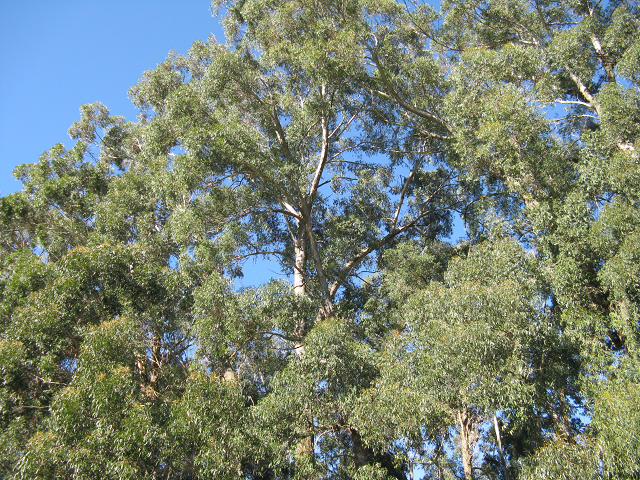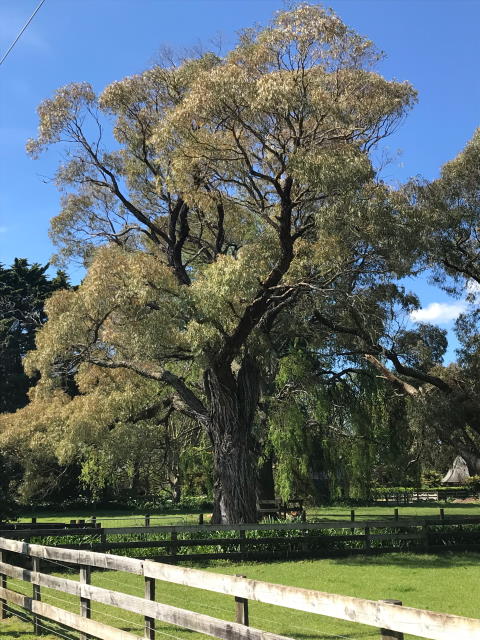
Eucalyptus species.
Cambridge is fortunate to possess several magnificent, towering stands of eucalyptus, along the river and in Te Ko Utu Park. Some of these trees may be over 100 years old. Identification of different species is difficult but the main ones present appear to be a stringybark, perhaps E. eugenoides, along with some Sydney blue gum, E. saligna. A remarkable all-purpose tree, eucalyptus wood is excellent for construction, flooring, joinery, panelling, furniture-making, outdoor decking, boatbuilding, fence posts, power poles and pulp for fine paper, while the oil has medicinal properties, and the nectar attracts honey bees.
The first eucalyptus trees in New Zealand were planted in 1836 by Rev James Hamlin at his mission station near the south head of the Manukau Harbour. They were possibly planted for their medicinal value since they dry up swamps where insects breed and exude insect-repelling oils. Some 60 years later Mother Mary Joseph Aubert was planting eucalyptus in the Whanganui river area for producing medicines to cure bronchitis and fevers, and Maori too had adopted their use for various ailments.
In the latter half of the nineteenth century New Zealand began importing massive amounts of eucalyptus timber from Australia. The first eucalyptus timber plantation in New Zealand was planted in Canterbury in 1860, with 50 species included, and in 1871 the government passed a Tree Planting Encouragement Act, recommending the use of blue gum in particular. However, extremely cold winters in 1886 and 1899 left only 12 surviving species; even some 40-year old blue gums succumbed. Shortly after this the spread of gum scale and other insect pests severely damaged many trees, and by the 1930s Pinus radiata had replaced eucalyptus as the tree of choice. However from the 1960s the use of eucalyptus has again seen a modest revival encouraged by the newly-formed Farm Forestry Association, and later by NZ Forest Products in their search for a better pulp product.
This is a good example:

This impressive tree stands sentinel at the entrance to a drive in St Kilda Road. I am not going to even guess at which of the 900 species of eucalyptus it is, but the thick rough bark on both its trunk and limbs suggests it may be an ironbark, perhaps one of the stringybarks or even a peppermint. This bark is vital for enabling the tree to survive even large fires.
Eucalyptus were first named in 1788 by the French botanist, Charles Louis L’Héritient de Brutelle, who sailed on James Cook’s third voyage. Discovering the thick, rough bark on a tree on Bruny Island, Tasmania he named it Eucalyptus obliqua, ‘eu’ meaning ‘well’ and ‘calyptos’ meaning ‘covered’. But their history is much more ancient than this. They go back to when Australia was part of the supercontinent, Gondwana: the oldest known eucalyptus fossil was found in Patagonia and carbon dated to 52 million years old, while genomic sequencing indicates that the species goes back 109 million years.
They are found predominantly in Australia, ranging from the alpine regions to the outback to the edge of the rain forest. The only place they do not grow is in the very arid regions. Aborigines used the rough bark to make canoes and shields, and today some trees that still bear the scars from this removal are identified as protected trees. The resin of most eucalypts smells strongly of either eucalyptus, lemon or peppermint, which serves to protect the trees from insect and other pest attack. Koala are the only animal to eat the leaves of eucalyptus, while the yellow-bellied glider lives on the resin, blunting its front teeth to tap into the flow through the thick bark. This resin has recognised anti-bacterial properties, and was used by Aborigines to treat cuts and wounds.

